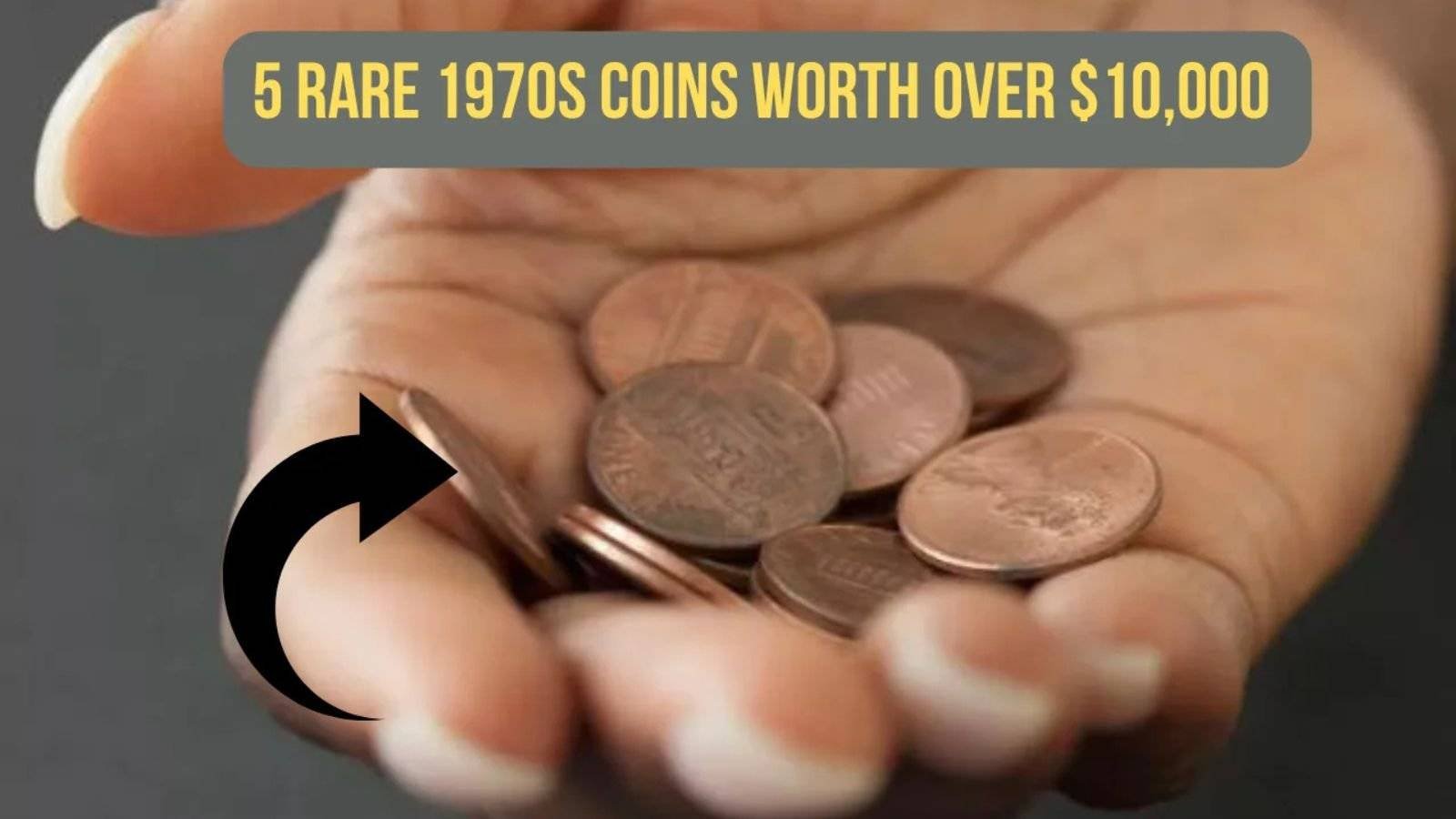For many people, coin collecting begins as a simple hobby, often sparked by curiosity or nostalgia. But occasionally, what seems like an ordinary coin tucked away in a drawer can be far more valuable than expected. Especially when it comes to rare 1970s coins, a surprising number of everyday-looking pieces can actually fetch thousands—or even hundreds of thousands—of dollars on the collectors’ market.
If you’ve inherited a collection or have old coins lying around, now’s the time to dig them out. In this article, we’ll explore five rare 1970s coins that are each worth more than $10,000. You don’t need to be a professional numismatist to spot them—just a keen eye and a little background knowledge might uncover a hidden gem in your possession.
Overview Table – 5 Rare 1970s Coins Worth Over $10,000
| Coin | Year | Estimated Value | Key Feature | Why It’s Valuable |
|---|---|---|---|---|
| 1970-S Small Date Lincoln Cent | 1970 | $10,000+ | Small-sized date, weak “Liberty” text | Rare variety, limited production |
| 1972 Doubled Die Lincoln Cent | 1972 | $15,000+ | Strong doubling on “LIBERTY” and the date | Well-known error coin, easy to verify |
| 1971 Eisenhower Silver Dollar (No S) | 1971 | $25,000+ | No mint mark, 40% silver content | Experimental strike, extremely rare |
| 1976 Bicentennial Quarter (Error Coin) | 1976 | $20,000+ | Wrong planchet or double die | Collector favorite, limited known errors |
| 1975 No-S Roosevelt Dime | 1975 | $450,000+ | Missing mint mark on proof version | Only a few known in existence |
Rare 1970s Coins: Why This Decade Matters
The 1970s marked a unique period in U.S. coin production. Several new coin designs were introduced, including the Eisenhower Dollar and the iconic Bicentennial coinage of 1976. Additionally, this decade saw technological advancements at the U.S. Mint that inadvertently resulted in a number of minting errors and anomalies. These factors combined to produce a variety of rare 1970s coins that are now highly sought after by collectors.
Coins from the 1970s generally feature straightforward, patriotic designs. Lincoln, Eisenhower, Roosevelt, and Washington remained prominent figures on these coins. Yet, it’s not always the design itself that makes a coin rare—it’s the mistakes, variations, and limited mintage numbers that transform ordinary coins into prized possessions.
What Makes Rare 1970s Coins So Valuable?
You might wonder why some small pieces of change can carry such astronomical price tags. Unlike modern high-tech gadgets, coins don’t “perform” in the usual sense, but their value comes from a combination of rarity, condition, and historical significance. Here’s what drives the worth of rare 1970s coins:
1. Minting Errors
Many valuable coins from this decade contain mint errors—accidents during production that went unnoticed at the time. These include:
- Double die errors (where part of the design appears duplicated)
- Missing mint marks (such as the 1975 No-S Dime)
- Wrong planchets (coins struck on metal blanks meant for different denominations)
2. Limited Production
Some versions of coins were produced in very small numbers, especially specific variants like the 1970-S Small Date Lincoln Cent. Lower mintage typically increases a coin’s rarity.
3. High Grades
Coins that are uncirculated and maintain a “mint state” condition (graded MS65 or higher) can be significantly more valuable. Grading is done by professional organizations like PCGS or NGC.
4. Historical Intrigue
Collectors are drawn to stories—why a coin was made the way it was, how it ended up being rare, and what makes it distinct from the standard issue. The mystery and uniqueness elevate the appeal of rare 1970s coins.
How to Identify Rare 1970s Coins in Your Collection
You don’t need to be an expert to spot a potentially rare coin. With a careful eye and attention to detail, you could very well discover a small fortune in loose change. Here’s how to get started:
1. Inspect the Date and Lettering
For coins like the 1970-S Small Date Lincoln Cent, you’ll notice that the date looks more compact and is positioned slightly higher than the common variety. Also, the word “LIBERTY” may appear weak or faint.
2. Look for Doubling
The 1972 Doubled Die Lincoln Cent is famous for the doubling seen on the date, the word “LIBERTY,” and the phrase “IN GOD WE TRUST.” It looks like a shadow or a blurry second image.
3. Check for Missing Mint Marks
One of the rarest coins, the 1975 No-S Roosevelt Dime, lacks the usual “S” mint mark that designates proof coins from San Francisco. Only two such dimes are known to exist today.
4. Examine the Coin’s Metal
Some rare 1970s coins were mistakenly struck on the wrong type of metal. A quarter may have the color or weight of a dime, for instance. These errors often create coins that are noticeably different in tone, weight, or even sound when dropped.
5. Get a Professional Opinion
If you suspect you’ve found a rare coin, the best course of action is to submit it to a professional grading service. Not only will they confirm its authenticity, but they’ll also assign it a grade, which helps determine market value.
Minting Techniques That Created Valuable Errors
Although minting technology in the 1970s was quite advanced compared to earlier decades, it was still prone to mechanical issues. These glitches led to the birth of some truly valuable rare 1970s coins:
- Double Die Errors: Occur when the die strikes the coin twice, creating a visible duplication.
- No Mint Mark Proof Coins: Proof coins are normally struck with extra care, and missing a mint mark is extremely unusual—making these coins particularly valuable.
- Wrong Planchet Errors: Occasionally, a coin was struck on a metal blank intended for another denomination, such as a dime blank being used for a quarter.
Each of these minting anomalies enhances the uniqueness and collectability of a coin.
Long-Term Value: Holding on to Rare 1970s Coins
Unlike most modern currency, which may lose value due to inflation, rare 1970s coins often appreciate in value over time. Coins that were once sold for a few hundred dollars have now reached values exceeding $10,000, $25,000, or even $450,000 at auctions. These coins not only serve as historical artifacts but can also be considered tangible investments.
Keeping these coins in excellent condition—stored in airtight holders and handled sparingly—can help preserve their value. Over time, their rarity and demand can turn a modest coin into a substantial asset.
FAQs About Rare 1970s Coins
Q1: How can I tell if my 1970s coin is rare?
Start by checking for odd features like doubling, unusual metal tone, or missing mint marks. Then, compare your coin to photos of verified rare examples online or get a professional appraisal.
Q2: Are all coins from the 1970s valuable?
No, only specific rare 1970s coins with errors, low mintages, or exceptional grades hold significant value.
Q3: Where can I sell my rare coin?
You can list them on platforms like eBay, Heritage Auctions, or go through reputable coin dealers. It’s always best to have the coin professionally graded first.
Q4: What’s the best way to store valuable coins?
Use acid-free coin holders or airtight plastic capsules. Avoid direct handling, as even fingerprints can reduce the value of high-grade coins.
Q5: Is coin collecting a profitable hobby?
It certainly can be. While not every coin will make you rich, finding or investing in rare 1970s coins can offer impressive returns over time.
Final Thoughts
Who knew that simple pocket change from the 1970s could potentially be worth thousands—or even hundreds of thousands—of dollars? These rare 1970s coins are much more than small discs of metal. They carry history, human error, and scarcity that make them highly desirable to collectors across the globe.
If you’ve got a jar of old coins sitting in a closet or a family heirloom coin folder gathering dust, take the time to look through them. You might just stumble upon one of these hidden treasures—turning an ordinary hobby into an extraordinary financial discovery.
Some Important Link
| Telegram Group | Click Here |
| WhatsApp Group | Click Here |
| Home Page | Click Here |










